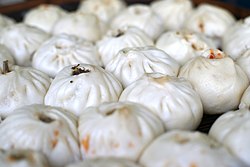
Back باوزي Arabic Паучи Bulgarian Bakpao BJN বাও Bengali/Bangla Baozi Catalan Baozi German Baozi Spanish Baozi Estonian Baozi Finnish Baozi French
This article needs additional citations for verification. (September 2014) |
 Meat-filled baozi for sale in a market | |
| Alternative names | Bao, humbow, pau, paotzu |
|---|---|
| Type | Filled steamed bread |
| Place of origin | China |
| Region or state | Greater China, East Asia, Chinatowns all over the world |
| Baozi | |||||||||||||||||||||
|---|---|---|---|---|---|---|---|---|---|---|---|---|---|---|---|---|---|---|---|---|---|
"Baozi" in Chinese characters | |||||||||||||||||||||
| Chinese | 包子 | ||||||||||||||||||||
| |||||||||||||||||||||
| Alternative Chinese name | |||||||||||||||||||||
| Chinese | 包 | ||||||||||||||||||||
| |||||||||||||||||||||
Baozi (Chinese: ⓘ), or simply bao, is a type of yeast-leavened filled bun[1] in various Chinese cuisines. There are many variations in fillings (meat or vegetarian) and preparations, though the buns are most often steamed. They are a variation of mantou from Northern China.
Baozi are popular throughout China and have even made their way into the cuisines of many other countries through the Chinese diaspora.
- ^ Phillips, C. (2016). All Under Heaven: Recipes from the 35 Cuisines of China. Ten Speed Press. p. 405. ISBN 978-1-60774-982-0. Retrieved November 5, 2016.